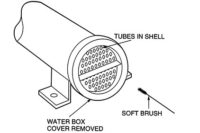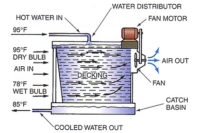Bob and Tim are going out to a new job. It’s an air cooled chiller on the rooftop of an office building. This is the first air cooled chiller that Tim has ever seen so Bob is going to have to describe the operation of the chiller to Tim.
Tim read the specifications of the chiller to Bob as they were riding down the road to the job. He said, “This is a 100 ton chiller with 2 reciprocating compressors used for the refrigeration. (Figure 1) It is an air cooled chiller so that means it has multiple fans. It is on the rooftop so we’re going to have to do all service from the ground to the roof. How do we get to the roof”?
Bob said, “Probably we will go up the elevator to the top floor of the building and there may be a set of stairs going to the roof or we may have to climb a ladder through a roof hatch. We will have to see what it’s like when we get there”.
When they got to the building they went in and talked to the building manager and he explained to them, to go to the sixth floor on the elevator and then gave them a key to a door that went up one flight of stairs to the roof. He explained to them that this was a security door and that they should keep the key in their possession the whole time.
They went to the truck and got their two pouches which included basic tools and flashlights and went to the rooftop. The chiller was sitting right out on the rooftop and Tim had a question, “this chiller is sitting outside, what prevents it from freezing in the winter time”?
Bob explained, “<ost likely the chilled water circuit uses glycol, which is a form of antifreeze, circulating in the chilled water portion of the building to prevent freezing. It may also have an evaporator heater which would be a strip of heat wrapped around the evaporator under the insulation, that operates by a thermostat. Anytime the outdoor conditions approach freezing the thermostat will turn on the heater. This system may have both types of freeze prevention. The reason for both is that the system probably has automatic water makeup and if there were a leak and the glycol were to leak out and the difference made up with water, it could possibly get into a condition of low glycol content which might allow it to freeze.
Tim asked, “What is the first thing we should do”?
Bob explained, “The first thing we should do is do a walk around and visually examine the whole system. We should open the electrical panel and look for potential hotspots, we can turn the power off and examine the contactors for the individual compressors and the condenser fan contactors to make sure they in good shape, at least visually. Look for overheated wires or anything strange in the control panel. If the contacts on the contactor don’t make good contact the wire leaving the contactor or entering will be scorched or burned looking. The sign of a loose connection in the contactor contacts. As you will notice the control panel is rather large because the unit has two compressors and eight condenser fan motors. The condenser fan motors cycle on and off to maintain a constant head pressure.
Tim then asked, “Are we going to do anything with the condenser fan motors”?
Bob said, “Yes we will open the inspection panels and check each motor for any bad signs and grease any motors that have grease fittings or oil for the oil cups. In other words we will lubricate each motor unless it is a permanently lubricated motor. (Figure 2) We should also reach up and turn each fan blade around by hand to make sure that each motor is turning freely”.
Tim took the control panel of and examined each fan motor very carefully and explained, “The fan motors all are freely turning and look great. I don’t think there is anything we need to do to the fan motors”.
Bob had been examining the main control panel and said, “The two leading compressor contactors are in pretty bad shape. (Figure 3) Let’s get contact kits and rebuild these contactors”.
After completing this maintenance Tim asked about the chilled water pump and Bob explained, “The chilled water pump is in the pump room on the top floor of the building. Let’s go there and lubricate the chilled water pump and motor. Then we will start the pump in the manual position and check the chilled water flow”.
They went to the pump room and found the chilled water pump and lubricated the pump and motor and Tim asked a question, “Why is the chilled water pump in the room downstairs”?
Bob said, “It was probably installed here to prevent freezing. It would have worked just as well to put the pump on the roof but it is more vulnerable to weather. The starter for the pump is over there on the wall, push the manual start button and let’s start the pump”.
Tim started the pump and it sounded good then he said, “I guess we should check the pressure drop across the chiller just like we did on the water cooled chillers”.
Bob said, “That is correct what is the pressure drop?".
Tim said, “The pressure drop is 12 psi. That is within range of what we talked about with water cooled chillers and I’m assuming that is good”.
Bob said, “Yes that is well within range. Now switch the pump starter back to automatic and the pump will turn off. Then we will start the chiller and the pump should start up automatically with the chiller. We will observe the chiller and watch it run and make sure that all four compressors will start up and run as well as the chilled water pump. The building water is warm enough that it should call for full load which will start all four compressors one at the time. Then as the building water begins to cool the compressors will begin to shut off until it gets down to the last compressor”.
They started the chiller and everything was working normal, all four compressors were running good all of the suction lines were nice and cold in the site glass was full as the liquid refrigerant entered the expansion valves on the chiller barrel.
Tim then asked a question, “What would happen to the system if the chilled water pump were to fail and stop running”?
Bob explained, “there must be some system to establish that water is circulating. If water is not moving in the system, the compressor must be stopped immediately, or a freeze condition could occur quickly. With a 100 ton capacity system and a small chiller evaporator full of water it quickly freeze. So a quick acting system must be used. A pressure differential control could be used from the inlet to the outlet of the evaporator water piping. Or a flow switch could be mounted in the chilled water piping to establish that water is flowing. This system has a paddle type flow switch. This it is mounted in the chilled water piping. If you pulled this control out of the piping you would see a brass paddle that protrudes down into the water. When water flows, the flow of the water will move the paddle switch and reposition the switch to allow the chiller to start. It’s an old reliable system”.
As they were riding away Tim commented, “Another day, another lesson. It is never dull”.
Publication date: 06/20/2018
Want more HVAC industry news and information? Join The NEWS on Facebook, Twitter, and LinkedIn today!











